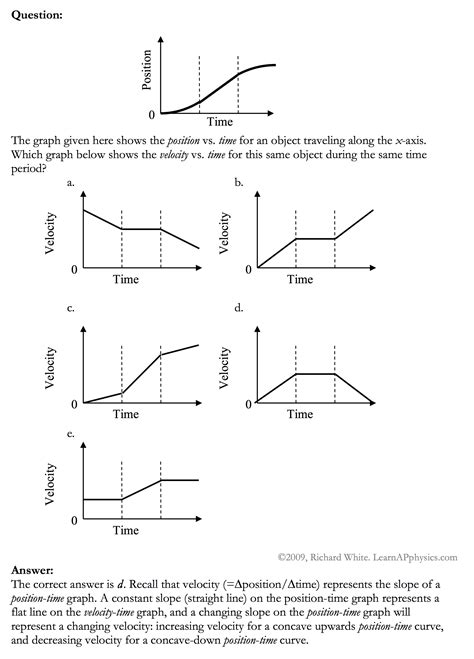Introduction

Kinematics, a fundamental branch of physics, delves into the study of motion and time, providing a deep understanding of how objects move and interact with their surroundings. In AP Physics 1, students embark on an exploration of this intriguing subject matter.
Displacement, Velocity, and Acceleration
Displacement
Displacement measures the change in position of an object, denoted by the vector quantity Δr. It indicates the distance and direction traveled.
Velocity
Velocity quantifies both the speed and direction of an object’s motion. It is represented by the vector quantity v, which is the rate of change of displacement with respect to time:
v = Δr / Δt
where Δt is the time interval.
Acceleration
Acceleration describes the rate of change of velocity with respect to time. It is a vector quantity a that can be either positive (speeding up) or negative (slowing down):
a = Δv / Δt
Motion with Constant Velocity
When an object moves with constant velocity, its displacement, velocity, and acceleration are all constant. The motion is described as linear and uniform.
Motion with Constant Acceleration
In the case of constant acceleration, an object’s velocity changes at a constant rate over time. This type of motion is often observed in free fall, where objects experience the acceleration due to gravity (g = 9.8 m/s²).
The equations of motion for constant acceleration are:
v = u + at
Δr = ut + 0.5at²
v² = u² + 2as
where u is the initial velocity, t is the time elapsed, and s is the distance traveled.
Projectile Motion
Projectile motion is a specialized case of motion with constant acceleration, where an object is launched into the air at an angle to the horizontal. The equations for projectile motion include:
Horizontal Motion:
Δx = v₀t cos θ
Vertical Motion:
Δy = v₀t sin θ – 0.5gt²
where v₀ is the initial launch velocity, θ is the launch angle, and t is the time elapsed.
Applications of Kinematics
Kinematics plays a crucial role in countless applications:
- Engineering: Design of bridges, vehicles, and aircraft
- Sports: Optimizing performance in running, swimming, and cycling
- Medicine: Determining the trajectory of projectiles, such as medical imaging and surgery
Pain Points and Motivations
Pain Points:
- Understanding the concepts of displacement, velocity, and acceleration can be challenging for some students.
- Applying kinematics equations to real-world scenarios can be complex.
Motivations:
- Kinematics is essential for understanding more advanced physics concepts, such as dynamics and energy.
- It has practical applications in various fields, from engineering to sports.
- Mastering kinematics enhances analytical thinking and problem-solving skills.
Effective Strategies
Strategies:
- Break down concepts: Divide complex concepts into smaller, manageable chunks.
- Practice with equations: Solve numerous practice problems to develop proficiency.
- Use visual aids: Diagrams and graphs can help visualize kinematics concepts.
- Seek clarity: Don’t hesitate to ask for help from teachers or peers when needed.
Pros and Cons
Pros:
- Provides a foundation for understanding more complex physics topics
- Has practical applications in various fields
- Enhances analytical thinking and problem-solving abilities
Cons:
- Some concepts can be challenging to grasp
- Requires mathematical proficiency
- Can be abstract and difficult for students who prefer hands-on learning
Useful Tables
Table 1: Kinematic Equations
| Equation | Description |
|---|---|
| v = u + at | Velocity-time relationship |
| Δr = ut + 0.5at² | Displacement-time relationship |
| v² = u² + 2as | Velocity-displacement relationship |
Table 2: Projectile Motion Equations
| Equation | Description |
|---|---|
| Δx = v₀t cos θ | Horizontal displacement |
| Δy = v₀t sin θ – 0.5gt² | Vertical displacement |
Table 3: Coordinates and Vectors
| Term | Description |
|---|---|
| Δr | Displacement vector |
| v | Velocity vector |
| a | Acceleration vector |
Table 4: Motion Types
| Type | Description |
|---|---|
| Constant velocity | Displacement, velocity, and acceleration are constant |
| Constant acceleration | Velocity changes at a constant rate over time |
| Projectile motion | Specialized case of motion with constant acceleration in two dimensions |
Conclusion
Mastering AP Physics 1 Kinematics equips students with a solid understanding of motion and time. Through the study of displacement, velocity, and acceleration, they develop the analytical and problem-solving skills that are essential for success in science, engineering, and beyond. By embracing the challenges and utilizing effective strategies, students can unlock the secrets of kinematics and unlock their full potential in physics.
